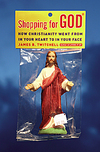 This is part two in a series from the book by James B. Twitchell titled Shopping for God: How Christianity Went From In Your Heart To In Your Face.
This is part two in a series from the book by James B. Twitchell titled Shopping for God: How Christianity Went From In Your Heart To In Your Face.
Twitchell starts the book with a nice summary of what it’s all about. “Essentially, this book is about how religious sensation is currently being manufactured, branded, packaged, shipped out, and consumed.” He takes the first chapter and gives a sweeping overview of the “Spiritual Marketplace.” His observations are viewed entirely with a consumer mentality as he looks at movies, television, radio, Internet and books. Twitchell wants his readers to see how our crave for spirituality is being met with product experiences that we purchase. Just as Madison Avenue says we drink the advertising not the beer, so Twitchell says that what we buy is the story. The product is thrown in for free.
Movies
“If as the saying goes, the religion of Hollywood is money, then the returns of Christiantainment have proven a God-send.” It was the marketing of 1950s movies like The Robe, The Ten Commandments and Ben Hur that actually brought the ten commandments into public space says Twitchell. In partnership with a nationwide association of civic-minded clubs founded by theater owners, Cecil B. DeMille worked out a publicity plan for his movie The Ten Commandments. They sponsored “the construction of several thousand Ten Commandments monuments throughout the country.” Interestingly, it was two of these “granite monuments, first in Alabama and then on the grounds of the Texas capital in Austin” that “became the focus of the Ten Commandments case before the U.S. Supreme Court. Says Twitchell, “What was essentially an advertisement for an entertainment has become a deadly serious pronouncement of in-your-face-faith.”
Modern day films that have partnered with “faith” include Mel Gibson’s The Passion, Left Behind and The Chronicles of Narnia. The revolution that is happening is that movie makers are seeing the church as a next big delivery system because there are over two hundred thousand churches in American compared to five thousand theaters. As churches become more and more tech savvy with giant screens and sound, it will be a natural tie in.
Television & Radio
Although the Christian ghetto got off to a rocky start (think Oral Roberts, Pat Robertson, Jim Bakker, Jimmy Swaggart), it has been shows like Touched by an Angel, Revelations and The Book of Daniel that have been more of a relevant answer to our hunger for spirituality. Aside from soundness of doctrine, shows like these, along with prime-time specials like Dateline NBC’s “The Last Days of Jesus” or ABC News’ three hour special on Jesus and Paul are typically a jumbled mix of multi-faith messages appealing to viewers that beget advertisers.
Radio has taken evangelism and music mainstream as preaching stations and Christian boy bands also meet a need for Christian consumption. “Music is crucial to religion because it is so emotional and resolutely nonintellectual. You can’t explain a piece of music, you can only feel it.”
Internet
“Right behind viewing porn, the next most popular use of the internet is for religious purposes.” The Pew Research Center says that 64 percent of the nation’s 128 million internet users say the use the web for religious or spiritual purposes. This explains why, says Twitchell, so many denominations and megachurches have web sites, some very sophisticated. “Nearly 6 out of every 10 Protestant churches now have a dedicated web site.”
Twitchell also mentions blogging as a major platform for spiritual conversation:
“For our purposes, some of the most interesting blogs are those dealing with How To Market Your Church, like the amazingly named but really sophisticated site churchmarketingsucks.com. Here the casual visitor can get a sense of how clergy attempt to position their product in a highly competitive market. They even link you to shipoffools.com, which encourages readers to submit their most offensive religious jokes.”
Book Publishing
From The Purpose Driven Life to The Da Vinci Code, this is one of the more obvious and well known spiritual consumption categories.
“One reason why the American religious enterprise is so explosive is because it is just that: an enterprise.” Twitchell prints a quote that has been attributed to Richard Halverson, former Chaplain of the United States Senate:
“In the beginning the church was a fellowship of men and women centering on the living Christ. Then the church moved to Greece, where it became a philosophy. Then it moved to Rome, where it became an institution. Next, it moved to Europe, where it became a culture. And, finally, it moved to America, where is became an enterprise.”
In summary, Twitchell points to research from Eva Hamberg and Thorleif Pettersson that shows how a competitive market spurs innovation and increases consumption. In other words, the reason the spiritual market continues to grow is because it feeds off itself. The U.S. has the highest weekly church attendance and the most diverse supply of religious pluralism in the world.




Gordon
January 17, 2008
Can’t hurt when he plugs the current website. ;-)
Although I’m guessing (having only read your review) that he doesn’t see you (and all of us who read it) as doing a particularly good thing by trying to improve the quality of church marketing.